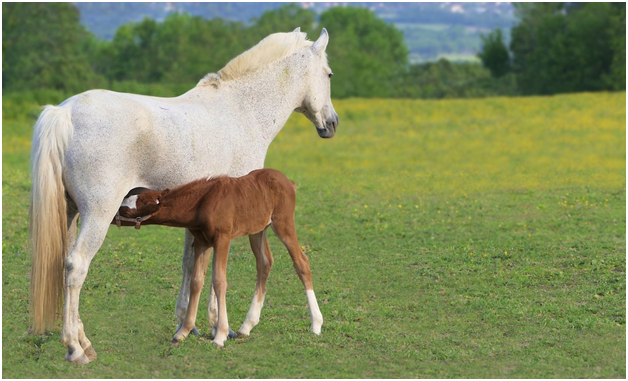Recently, there are more horses with different front hooves, when one is lower, wider with a well-developed frog (the left as a rule) and another is narrow, upright, with depressed frog, so called “grass” foot. The owner of the horse, unlike the farrier, often does not pay attention to this until the horse is limp when trotting. But the horse might not limp. Attempts to make the hooves the same with the help of trimming or gymnastic exercises do not bring results.
To understand how the "grass" foot is formed, you need to go back to the early life of the foal. While the foal feeds on its mother's milk, its hooves are the same size. With the transition to pasture food in order to reach the grass the foal spreads its legs wide like open scissors; in front as a rule is the left leg, the right leg is behind, under the body. And there is an explanation for this. The fact is that the right half of the brain is responsible for the orientation in space in a horse.
A similar phenomenon is observed in humans: it is the right half of the brain that is responsible for orientation in space and motor activity. Has anyone ever wondered why a line of soldiers starts moving with their left foot? Evolution decreed that the left side of the body is controlled by the right hemisphere of the brain, and the left – right.
- The foal grows very quickly and in one day of grazing is able to significantly grow the heel of the hoof on the foot placed under the body, especially since in this position it leans mainly on the toe. On the other foot, which is extended far forward, the press is on the heel and it constrains heel growth. During the night when the foal is in the stable, the acquired asymmetry is not only fixed but also the adaptation to it takes place. For tomorrow and the following days everything is repeated; the fetlock joint is straightened. The flexor muscles of the hoof and fetlock joints assume their usual position. The formation of the “grass” foot has begun!
- Foals are born long-legged, similar to spiders, and already after a couple of hours are able to move along with the herd. Of all the parts of the foal’s body, the legs are the most developed in the womb. Therefore, it’s quite natural that in cultural horse breeds in which the height of the parents may be 160 centimeters and above at the withers, that foals with very long limbs are born. It should be noted that among native breeds, where the height of the animals does not exceed 140 cm (like clapper for example) the “grass” foot is not found but among cultured species – it is very often. Probably the breeder’s activity has destroyed the natural harmony of the growth of these animals.
- Straightening the fetlock joint leads to an increase in the length of the limb compared to the next one, though “the length of the bones is the same” (O’Grady). There is not a collarbone in a horse and scapula is attached directly to the body trunk by a serrated muscle. The shoulder blade cannot move up and then under the action of the pushing force directed from the bottom up the chest is displaced. The fact that this happens is proved by the curvature of the spine, the different curvature of the pectoral muscles and the bulge in the withers on the left side. The displacement of the chest leads to a change in the position of the horse's center of gravity. It also shifts to the left. This explains the fact that the horse is much more willing to make turns to the left and more easily rises to a gallop with the left leg.
- If for amateur riding it does not matter much then for performances at a high level such a horse is not suitable. “Asymmetry in hoof spread measurements suggest unequal loading of the limbs, which in turn may contribute to injure and reduces performance.” (Wilson GH, Mc Doanald K, O’Connel MJ, Equine Veterinary journal, 2009, Mar.: 41(3) 238-241).
It is possible to prevent the formation of a “grass” foot if addressed at the early age of the foal, specifically as soon as it began to graze. Each day, take a rasp to remove the heel of the hoof that has grown during the day and do not give it hay for the night from the floor. You should not allow the muscles to take the "usual" shortened position.








Post a comment
Report Abusive Comment